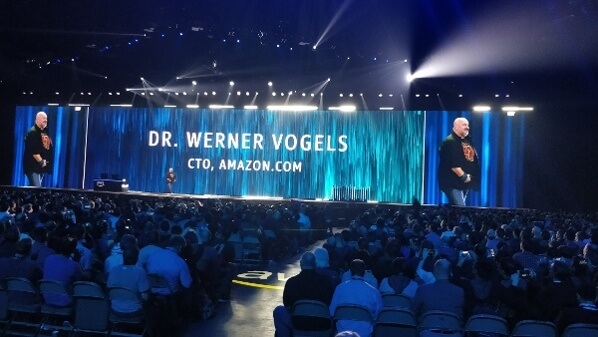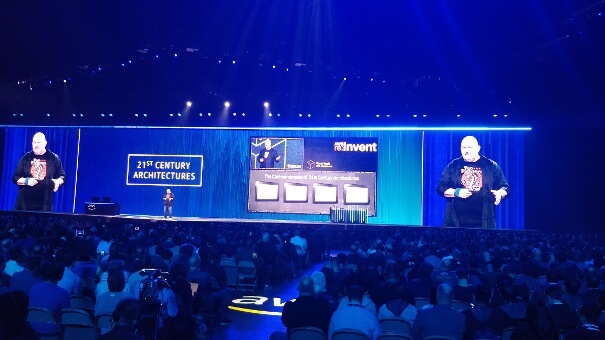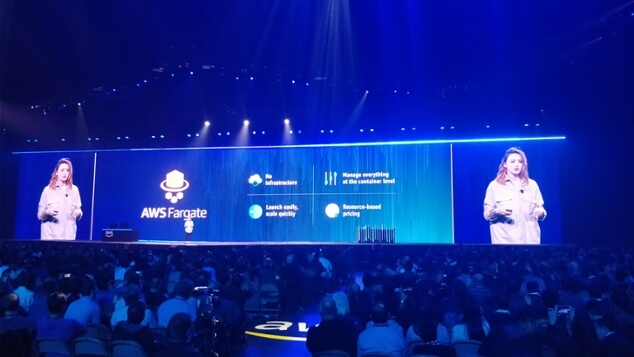ARCHITECTURE FOR THE 21ST CENTURY GENERATION – THIS TIME, RE:IMAGINED
Post • 6 min read
Much like the last 5 years at re:Invent, we were treated on the Thursday to a keynote by Werner Vogels, speaking at the MGM Grand Garden Arena. It's a huge space and the production values that AWS brings to their keynotes (coupled with the 16,800 capacity) made for an electric start to the morning.
Vogels started the keynote by reflecting on the keynotes he has delivered over the last 5 years. During his first ever keynote back in 2012, Vogels discussed 21st-century architecture. He provided 4 guiding commandments: Controllable, Resilient, Adaptive, and Data Driven. He returned to this theme by calling this particular keynote '21st Century Architectures, re:Imagined'
 It was made clear from the start that, unlike previous years, there would be relatively few announcements. He was true to his word, and instead focussed on just a few key themes. Vogels took time to thank AWS's customers, reflecting that in the beginning, they knew they had to be collaborative to succeed. They wanted to build a collection of 'nimble' tools which could be assembled to build what customers needed. AWS listen to customer feedback, launching services that are rock solid, then working with customers to set the roadmap and development priorities.
AWS want to help you build services for the future, and a lot of the announcements this week are enabled by developments in technology that have come about in the last 2-3 years.
It was made clear from the start that, unlike previous years, there would be relatively few announcements. He was true to his word, and instead focussed on just a few key themes. Vogels took time to thank AWS's customers, reflecting that in the beginning, they knew they had to be collaborative to succeed. They wanted to build a collection of 'nimble' tools which could be assembled to build what customers needed. AWS listen to customer feedback, launching services that are rock solid, then working with customers to set the roadmap and development priorities.
AWS want to help you build services for the future, and a lot of the announcements this week are enabled by developments in technology that have come about in the last 2-3 years.


 It was made clear from the start that, unlike previous years, there would be relatively few announcements. He was true to his word, and instead focussed on just a few key themes. Vogels took time to thank AWS's customers, reflecting that in the beginning, they knew they had to be collaborative to succeed. They wanted to build a collection of 'nimble' tools which could be assembled to build what customers needed. AWS listen to customer feedback, launching services that are rock solid, then working with customers to set the roadmap and development priorities.
AWS want to help you build services for the future, and a lot of the announcements this week are enabled by developments in technology that have come about in the last 2-3 years.
It was made clear from the start that, unlike previous years, there would be relatively few announcements. He was true to his word, and instead focussed on just a few key themes. Vogels took time to thank AWS's customers, reflecting that in the beginning, they knew they had to be collaborative to succeed. They wanted to build a collection of 'nimble' tools which could be assembled to build what customers needed. AWS listen to customer feedback, launching services that are rock solid, then working with customers to set the roadmap and development priorities.
AWS want to help you build services for the future, and a lot of the announcements this week are enabled by developments in technology that have come about in the last 2-3 years.
Voice As A Control System
One of the themes Vogels spoke about was IoT and allowing whole environments to become accessible. Every device has the ability to become an input or output device, but with so many out there, it's good to consider how we interact with all of them and their systems. Vogels believes that digital interfaces of the future will be human-centric, and the things that we as humans use to communicate will become the inputs to systems. The first of these will be the voice as it's the most natural and easiest interaction. Once you can use your voice to control systems, Vogel suggested people won't look back, from surgeons operating theatre equipment, to simply controlling the lighting or heating in your house, it will unlock digital systems for everyone. To demonstrate this point, Vogels talked about the International Rice Research Institute who provide rice farmers advice on how much and which fertiliser to put on their crops based on their years of research. Consumption of this information was very low until they invested in a voice interface. Farmers can call, select from one of 27 dialects, and provide information on their land and crop conditions. They then use voice recognition and machine learning to read back to the farmer which fertilizer they need. This was building up to the announcement of Alexa Business, a service that 'makes it easier for you to introduce Alexa to your organization, providing the tools you need to set-up and manage Alexa enabled devices, enroll users, and assign skills at scale'Ensure You Are Well Architected
The next theme of the keynote was architecture. Typically, systems have three planes: Admin, Control, and Data. (Vogels suggested architecture that extensive was difficult to visualise on marketing slides!) The AWS Well Architected Framework was launched two years ago and has grown from a single document to five pillars across five documents with two 'lenses'. It guides the user on how to architect for specific use cases, (currently HPC and Serverless). The framework is included in AWS certifications and AWS regularly run boot camps and 'Well Architected Reviews' for its customers.
Dance Like No One Is Watching, Encrypt Like Everyone Is
This particular section had a strong focus on security and availability. On security, Vogels recapped everything you need to ensure you are doing, from implementing a strong identity foundation to automating security best practices. The need to encrypt everything was also highlighted and security has become a problem for all. Developers are now seen to be the new security team and everything needs to be remembered. For example, ensuring the security of the CI/CD pipeline, as well as ensuring security within the pipeline. Development has also changed over time, meaning you need to be more security aware. It's more collaborative, there are more languages, and more services and teams are combining. To help out, AWS have launched Cloud9, a cloud-based IDE, including a code editor, debugger, and a terminal pre-packaged with essential tools (JavaScript, PHP, Python), to allow you to write, run and debug your code, so you don't need to set-up your development environments to start new projects.Everything Will Fail. All The Time
Availability, reliability, and resilience were discussed, from the basics, (hard dependencies reduce availability, redundant dependencies increase availability) to the best practices of Distributed Systems, through to deployment automation and testing. Nora Jones (Netflix), gave the example of using Chaos Engineering and how they do this at Netflix. Vogels highlighted that available systems cost more and therefore it becomes a business decision whether to easily run something in a single availability zone, but only achieve 99% of uptime. If you want to increase this you need to distribute your services across multiple availability zones or even regions. DynamoDB Global Tables, for example, help you to do this, becoming the ultimate tool in reliability design. Although this has little to do with AWS (and more to do with decisions made within organisations), AWS can make this much easier for you. This brings us nicely onto the final part of the keynote - letting AWS do the 'heavy lifting' through its managed services. Galls Law says, "A complex system that worked is invariably found to have evolved from a simple system that worked". AWS allows you to keep your systems simple by providing nimble services which you can assemble to build what you need. If you run your own RDBMS, you have to take care of the control and data planes. If you run on AWS, AWS manages the control plane. AWS Managed Services are designed for AWS to control the complex and hard to manage moving parts. making it simpler for you. This was demonstrated by Abby Fuller speaking about containers on AWS, and how Amazon Fargate can help you to make your environment much more simple. AWS will continue to release managed services over the next year.
Serverless
Serverless was something that couldn't possibly be missed out of this keynote, with it being the ultimate AWS Managed Service. There is no server management, has flexible scaling, high availability, and no idle capacity. Here are the final (Lambda) product announcements- API Gateway VPC integration
- Concurrency Controls
- 3GB Memory Support &
- .NetCoe 2.0 & GO language support
Get in Touch.
Let’s discuss how we can help with your cloud journey. Our experts are standing by to talk about your migration, modernisation, development and skills challenges.

Ilja’s passion and tech knowledge help customers transform how they manage infrastructure and develop apps in cloud.
Ilja Summala
LinkedIn
Group CTO